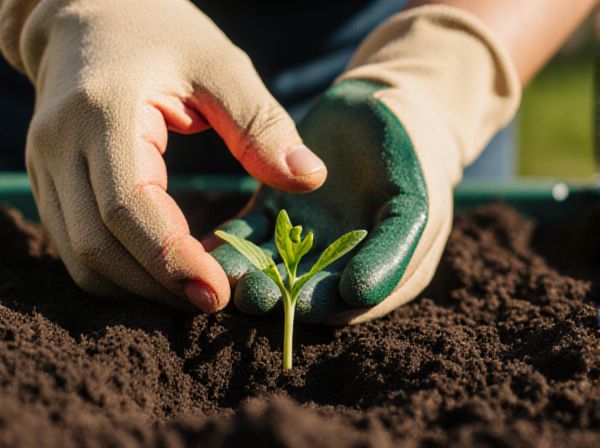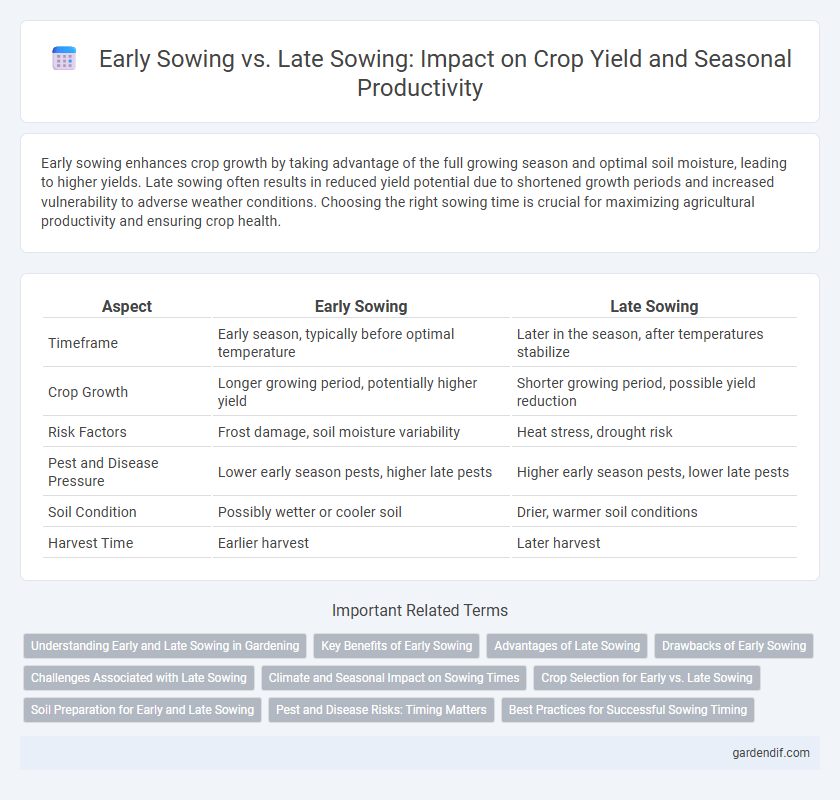
Early sowing vs Late sowing Illustration
Early sowing enhances crop growth by taking advantage of the full growing season and optimal soil moisture, leading to higher yields. Late sowing often results in reduced yield potential due to shortened growth periods and increased vulnerability to adverse weather conditions. Choosing the right sowing time is crucial for maximizing agricultural productivity and ensuring crop health.
Table of Comparison
| Aspect | Early Sowing | Late Sowing |
|---|---|---|
| Timeframe | Early season, typically before optimal temperature | Later in the season, after temperatures stabilize |
| Crop Growth | Longer growing period, potentially higher yield | Shorter growing period, possible yield reduction |
| Risk Factors | Frost damage, soil moisture variability | Heat stress, drought risk |
| Pest and Disease Pressure | Lower early season pests, higher late pests | Higher early season pests, lower late pests |
| Soil Condition | Possibly wetter or cooler soil | Drier, warmer soil conditions |
| Harvest Time | Earlier harvest | Later harvest |
Understanding Early and Late Sowing in Gardening
Early sowing maximizes the growing season by taking advantage of cooler soil temperatures that promote seed germination for crops like lettuce and peas. Late sowing can help avoid frost damage and is ideal for heat-tolerant plants such as tomatoes and peppers, though it shortens the overall growth period. Gardeners optimize yield by selecting sowing times based on crop requirements and local climate patterns.
Key Benefits of Early Sowing
Early sowing maximizes crop yield by providing plants with an extended growing period, enhancing nutrient uptake and root development. It reduces vulnerability to late-season pests and diseases by allowing crops to mature before peak infestation periods. Early sowing also improves water-use efficiency by taking advantage of available soil moisture and favorable temperature conditions.
Advantages of Late Sowing
Late sowing enhances crop resilience by aligning plant growth with optimal environmental conditions, reducing exposure to early-season frost and drought stress. This practice can improve soil moisture retention and increase nutrient availability, supporting healthier plant development. Farmers benefit from better pest and disease management due to reduced overlap with peak pest activity periods commonly associated with early sowing.
Drawbacks of Early Sowing
Early sowing increases the risk of frost damage to young seedlings, which can severely reduce crop establishment and yield. It also exposes crops to early pest infestations and diseases, often requiring additional pest management interventions. Furthermore, soil conditions may be less favorable during early sowing, leading to poor seed germination and uneven plant growth.
Challenges Associated with Late Sowing
Late sowing often leads to reduced crop yields due to shorter growing periods and increased exposure to high temperatures during critical growth stages. This delay can exacerbate pest and disease pressures, making crop management more difficult and costly. Additionally, late sowing may result in poor soil moisture conditions, negatively impacting seed germination and overall plant development.
Climate and Seasonal Impact on Sowing Times
Early sowing allows crops to take advantage of optimal soil moisture and rising temperatures, reducing the risk of drought stress during critical growth stages. Late sowing often faces challenges from cooler temperatures and increased vulnerability to pests and diseases, which can delay germination and reduce yield potential. Climate variability, including shifts in precipitation patterns and temperature fluctuations, significantly influences the decision between early and late sowing to maximize crop productivity and resilience.
Crop Selection for Early vs. Late Sowing
Choosing crop varieties compatible with early sowing involves selecting those with shorter growing periods and higher frost tolerance to maximize yield and avoid damage from unpredictable cooler temperatures. Late sowing favors crops with greater heat tolerance and longer maturation times, allowing plants to fully develop despite delayed planting dates. Understanding phenological traits and stress resistance in seed varieties is crucial for optimizing growth cycles and ensuring successful harvests in varying seasonal windows.
Soil Preparation for Early and Late Sowing
Optimal soil preparation for early sowing involves thorough tillage to improve soil temperature and drainage, promoting rapid seed germination and root development in cooler conditions. For late sowing, soil should be lightly worked to preserve moisture and prevent compaction, ensuring adequate aeration while minimizing soil disturbance. Both approaches require precise nutrient management, with early sowing benefiting from pre-plant fertilization and late sowing focusing on residual soil fertility to meet crop demands.
Pest and Disease Risks: Timing Matters
Early sowing often increases exposure to pests like aphids and diseases such as rust due to favorable microclimate conditions during seedling development. Late sowing can reduce these risks by avoiding peak pest populations and periods of high humidity conducive to fungal pathogens. Crop rotation and monitoring remain essential regardless of sowing time to manage pest and disease pressures effectively.
Best Practices for Successful Sowing Timing
Early sowing ensures seeds benefit from prolonged growing periods and optimal soil moisture, enhancing germination rates and crop vigor. Late sowing reduces exposure to pests and diseases common in wetter conditions but requires careful selection of fast-maturing varieties to avoid yield loss. Employing soil temperature monitoring and regional climate data supports precise timing decisions, maximizing crop productivity and resilience.
Early sowing vs Late sowing Infographic

 gardendif.com
gardendif.com